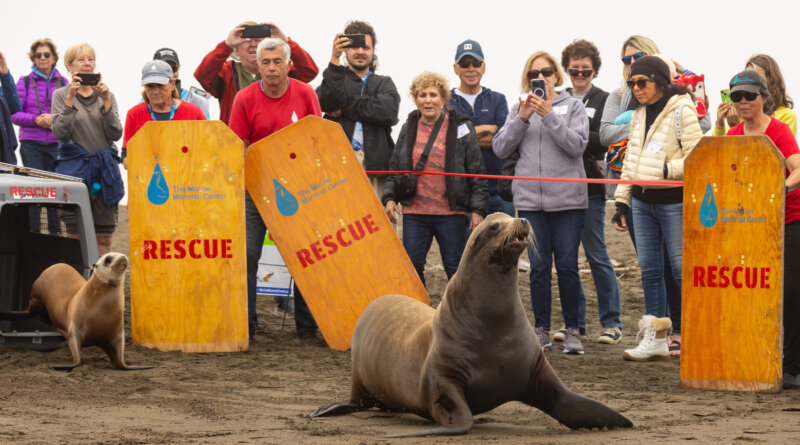A visit to the world’s largest marine mammal hospital : NPR

Volunteers from the Marine Mammal Center release California sea lions Quly (L) and Togozees (R) back to their ocean home at Rodeo Beach in Marin County, California, on August 4, 2023.
Bill Hunnewell/Giancarlo Rulli
hide caption
toggle caption
Bill Hunnewell/Giancarlo Rulli

Volunteers from the Marine Mammal Center release California sea lions Quly (L) and Togozees (R) back to their ocean home at Rodeo Beach in Marin County, California, on August 4, 2023.
Bill Hunnewell/Giancarlo Rulli
About two miles from the beach in Bodega Bay, California, there’s a small island where sea lions stop to rest. Despite the distance, I can hear the animals barking faintly.
Looking through a pair of binoculars – I pick out wiggling, cigar-shaped smudges along the lower parts of Bodega Rock.
Dozens and dozens of sea lions – all different shades of brown, tan and beige.
What could all that barking mean?
“It could be announcing that there’s really yummy food over here. It could be ‘hey look at me, look at me.’ It could be just wanting to be social, they enjoy being together,” said Adam Ratner, associate director of conservation education at the Marine Mammal Center.
“Here at the hospital they’re constantly engaging with each other. It’s just one way that they are really able to tell each other what’s on their minds.”
From the upstairs observation deck I can see dozens of pens, each with a small private pool. The hospital that day was providing care for 65 patients including elephant seals, otters, harbor seals and their most common patient: the California sea lion.
“We’ve got around 25 of them including this big guy right in the front row — an adult male named Togozees”. He’s lying listlessly in his pen. Ratner said Togozees was being treated for leptospirosis — a bacterial infection of the kidneys.
“Any test you can get at a human hospital, X-rays, surgeries, brain scans, we can do them right here to get those animals better and back out to the wild again,” said Giancarlo Rulli, the center’s spokesperson.
Sea lions and dolphins are more than cute. They tell us about ocean health for both marine mammals and people
Across the beaches of Southern California, hundreds of sea lions and dolphins are washing up dead or sick from toxic algae. The Marine Mammal Center discovered the harmful algae bloom in 1998, and receives approximately 100 animals per year because of this.
“That’s something where we can work with other groups across the country to help provide care and learn from how we’ve been able to treat those animals and rescue them. And then that helps inform the public policy to keep the people safe from eating toxic fish.” Ratner explained.

Adam Ratner, associate director of conservation education at The Marine Mammal Center in Sausalito, California.
Bill Hunnewell/Giancarlo Rulli
hide caption
toggle caption
Bill Hunnewell/Giancarlo Rulli

Adam Ratner, associate director of conservation education at The Marine Mammal Center in Sausalito, California.
Bill Hunnewell/Giancarlo Rulli
The center also makes “house calls” to treat animals that don’t fit into a volunteer’s pickup truck.
“We’ve gone out and actually administered medication to animals that have been hit by boats, we’ve disentangled whales that have been caught in trash, so we can still give those really large animals that second chance they deserve.”
In the chart room, Rulli points to a white board with a layout of the pens that shows the location of each patient.
“These are the manila envelopes, just like at a doctor’s office with the name.” Rulli opens a chart and reads. “So this one here is Tati. He’s in IE6, which is in our intensive quarantine area. It’s the 5,039th elephant seal to come through our hospital’s doors.”
“An army of volunteers”
Rulli started here as a volunteer when he was 14. He still volunteers, but he’s also on staff. He said the Center depends on its “army of volunteers”, which contributes more than 150,000 hours every single year to the operations.

Giancarlo Rulli stands next to a volunteer vehicle at the Marine Mammal Center
Giancarlo Rulli
hide caption
toggle caption
Giancarlo Rulli

Giancarlo Rulli stands next to a volunteer vehicle at the Marine Mammal Center
Giancarlo Rulli
“We have volunteers as young as 15 on our youth crew. And we have volunteers that are in their 90s. We could not do the work that we do everyday without them.”

Volunteers from the Marine Mammal Center release California sea lions Quly (L) and Togozees (R) back to their ocean home at Rodeo Beach in Marin County, California, on August 4, 2023.
Bill Hunnewell/Giancarlo Rulli
hide caption
toggle caption
Bill Hunnewell/Giancarlo Rulli

Volunteers from the Marine Mammal Center release California sea lions Quly (L) and Togozees (R) back to their ocean home at Rodeo Beach in Marin County, California, on August 4, 2023.
Bill Hunnewell/Giancarlo Rulli
Several of those volunteers are hard at work in the “fish kitchen” preparing today’s lunch. Ratner says the animals can go through a thousand pounds of fish every day.
“Our volunteers will separate out the fish into buckets, typically throw that food into the water, let the animals fight over it. That way, they keep those wild, naturalistic instincts, to help them go back out to the wild.”
Food for ailing sea lions
In the walk-in cooler, there’s lots of sustainably-sourced herring – the primary food for the seals and sea lions. There are also squid, shrimp, crabs and clams for the otters that come through the hospital.
Finally it’s time for lunch so we follow two volunteers as they prepare to feed Togozees — the adult male sea lion suffering from leptospirosis.

Adult male sea lion Togozees was a patient at the Marine Mammal Center in July.
Giancarlo Rulli
hide caption
toggle caption
Giancarlo Rulli

Adult male sea lion Togozees was a patient at the Marine Mammal Center in July.
Giancarlo Rulli
“He’s clearly ill, he’s got a disease but he knows how to eat fish, so all we’re gonna do is throw the fish in the water, let him chase after it and that’s gonna be his lunchtime feed.”
After the fish splash into the pool, Ratner grabs the bucket from the volunteer and reads from the paper stuck to the side: “So he got around five pounds of fish just at this meal alone. As an adult male he’s weighing over 300 pounds.” Still underweight Ratner says.
About 25 thousand animals have been through the hospital since it first opened in 1975 and every one of them gets a unique name. But why Togozees – and who gets to choose?
“It’s actually the person out on the beach – the member of the public typically that finds the animal that calls us that gets to name them. They just have to be really creative with the naming more than anything else,” Ratner explained.
After eating his five pounds of fish — Togozees lets out a couple of loud barks.
I ask if that might mean “give me some more fish,” and Ratner laughs, adding “It could be any number of things but we know the second that he gets that clean bill of health he’s gonna be back out in the wild with all of his friends.”
And that’s exactly what happened. Thanks to the care he received at the Marine Mammal Center — Togozees made a full recovery.

Quly (foreground) and Togozees, two sea lions successfully treated for leptospirosis at the Marine Mammal Center, return to the ocean on August 4, 2023.
Bill Hunnewell/Giancarlo Rulli
hide caption
toggle caption
Bill Hunnewell/Giancarlo Rulli

Quly (foreground) and Togozees, two sea lions successfully treated for leptospirosis at the Marine Mammal Center, return to the ocean on August 4, 2023.
Bill Hunnewell/Giancarlo Rulli
Earlier this month, a crowd of donors, volunteers and staff gathered on the nearby beach to watch Togozees and his fellow patient Quly waddle out of their carriers — then sprint to the ocean.
When the animals reached the water, the crowd broke into applause.
The Marine Mammal Center
YouTube





